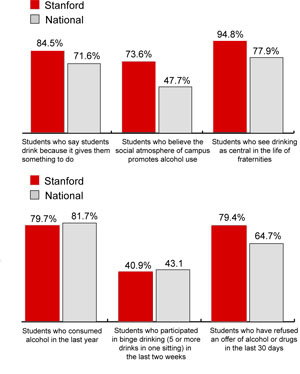
Stanford undergraduates fall just below national averages in alcohol consumption, according to a survey conducted by the Office of Alcohol Policy and Education (OAPE). The survey indicated, however, that Stanford is above average in having alcohol as the center of campus social life, in hard liquor use and in pre-gaming before events.
According to OAPE Director Ralph Castro, the survey was conducted as part of a larger Stanford alcohol initiative including the recent development of the OAPE office. The office used a standard, national survey from the Core Institute in order to compare responses to standard questions with survey results from other institutions.
This year, 583 students took the survey. Castro said OAPE will conduct the same survey every year to evaluate trends over time.
Compared with the national average of 81.7 percent, 79.7 percent of Stanford students said they had consumed alcohol in the past year. The average number of drinks consumed per week fell well below average, at 3.6 versus the national 4.6.
Despite the near average numbers for overall alcohol consumption, Castro said that some of the more specific drinking habits at Stanford still might be cause for concern and University action.
“We are above national averages for students who take shots of alcohol, who drink hard liquor and who engage in pre-gaming,” Castro said. “Those situations … are risk factors for negative consequences to happen.”
OAPE added several questions to the Core Institute survey to evaluate these high-risk behaviors. According to Castro, 53.4 percent of students reported pre-gaming in the last 30 days. Many more students — 32.2 percent — reported drinking primarily hard liquor than students who reported drinking primarily beer — 24.3 percent.
Castro said that 56.9 percent of students reported ever having taken a shot of hard liquor.
“It reaffirms what our thought was,” Castro said of OAPE’s reaction to the high-risk drinking numbers. “We know that [pre-gaming and hard liquor] are our two big risk factors, and we know we need to provide some targeted education in those areas.”
Castro also noted that the trend toward hard liquor, which is typically served in quantities that are difficult to measure, could exacerbate underestimation by drinkers of overall alcohol consumption. Castro specifically referred to the average of 3.6 drinks per week, noting that when drinking hard liquor, students might not know how much alcohol they are consuming.
Despite the tendency toward hard liquor and pre-gaming, Stanford still fell below national numbers in the Core Institute survey for binge drinking, which is usually considered a metric of high-risk drinking behavior. At Stanford, 40.9 percent of students reported having five or more drinks in a row in the last two weeks, whereas nationally 43.1 percent reported the same behavior.
Another area of concern for OAPE is in the alcohol-centered culture that students reported experiencing at Stanford. Notably, 84.5 percent of students said that people at Stanford drink because it gives them something to do, almost 13 percent above the national average.
“To me that was a big one,” Castro said. “When people say the perceived effect of alcohol is that it just gives people something to do, then it means people are maybe just bored on given weekends.”
One of the largest divergences from national averages came from asking if students think the social atmosphere on campus promotes alcohol use. At Stanford, 73.6 percent of students said yes, whereas only 47.7 percent nationally said yes. Fraternities in particular were believed to promote alcohol use: 94.8 percent of students said they consider alcohol central to fraternity life, compared to 77.9 percent nationally.
“There isn’t anything else to do,” said Jacob Cruz ‘14, who said he does not drink. Cruz said that socially, he usually just abstains at events with alcohol present or does not go out.
“There’s different kinds of drinking scenes,” Cruz said. “You have the huge, big house parties, and then you have just the chill-backs. I enjoy those [chill-backs] a little bit more.”
OAPE started a program this year called Cardinal Nights to offer alternative, alcohol-free activities for the weekends, but the program is still in its infancy.
“For me [the survey] was clarification that we’re on the right track,” Castro said of OAPE’s response to the numbers.
One survey question, addressing student likelihood to attend alcohol-free events, divided students into thirds, according to Castro, with one third each saying they were likely to attend, unlikely to attend and unsure. Castro said he wants OAPE to adjust its offerings to target the unsure group.
“For me, we need to make it OK for people to want to go [to alcohol-free events],” Castro said.
Some numbers, however, indicated that students are already making healthy alcohol decisions. Nationally, 20.2 percent of students reported ever performing poorly in their schoolwork as a result of drinking, but only 12.7 percent of Stanford students reported the same. Stanford also fell below averages for vomiting or feeling nauseated because of alcohol and for other consequences like driving under the influence (6.9 percent at Stanford, 24.1 percent nationally).
“Even though only 13 percent of students say they’ve performed poorly on a test because of drinking, that’s still a significant number of students given our academic rigor,” Castro said.